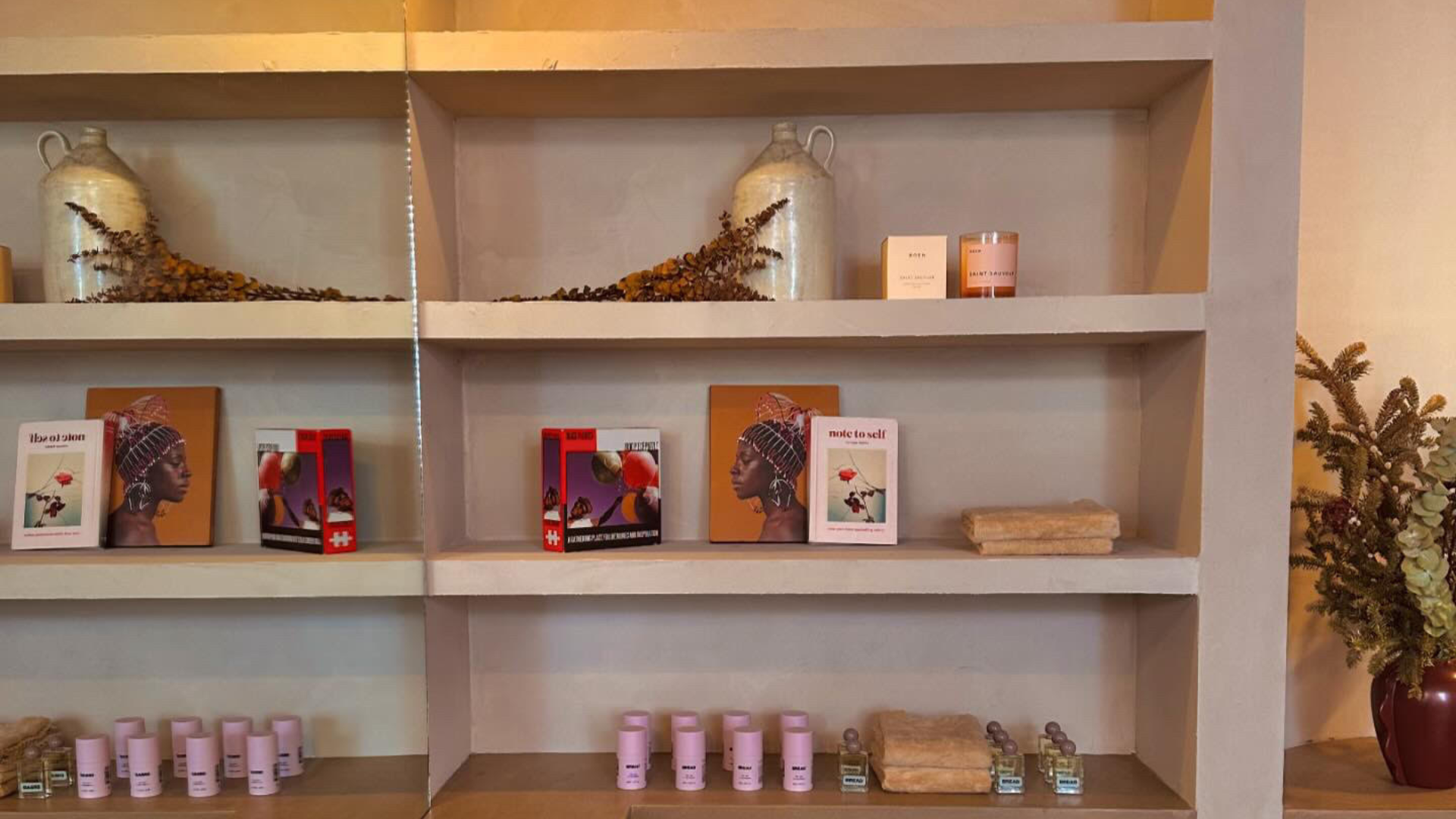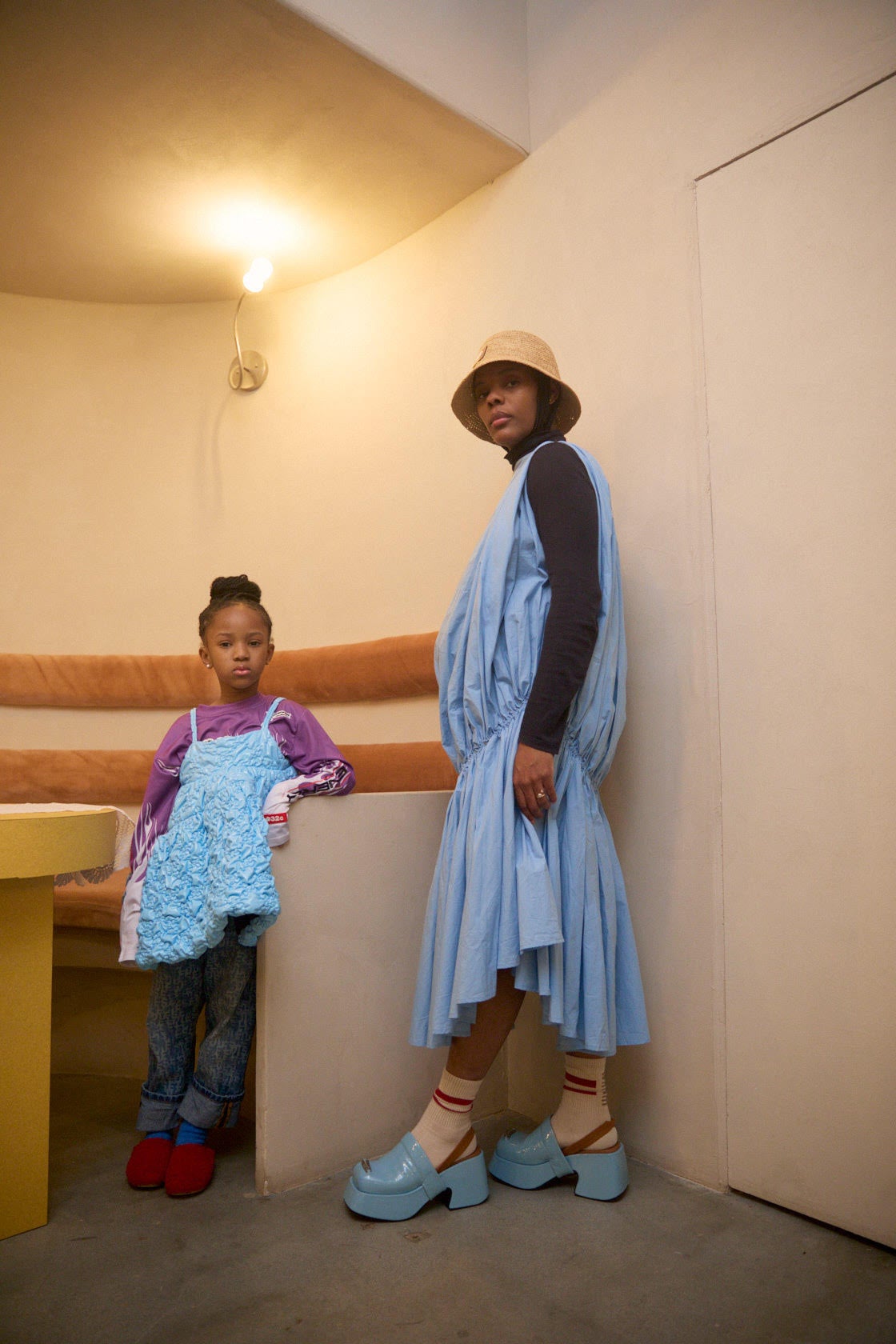














There is no other space quite like Lizzy Okpo’s ingenious brainchild, The Oma, Shop I and II. The Oma, Shop II, the second of her Harlem-based coffee, home and lifestyle shops opened just a year ago, and has infused the neighborhood with a new energy and excitement. The part wine bar, café, hairdresser, and concept store is as beautiful as it is warm. Beyond this, The Oma, Shop addresses a deeper void—one created by the gradual disappearance of spaces where Harlem’s commercial and communal spirit once thrived.
As someone raised in this neighborhood, who still lives here today, I often find myself lamenting on the lack of third spaces north of Central Park. Largely a result of rapid gentrification that’s only accelerated in the last two decades, the many small Black-owned stores, lounges, and restaurants that once peppered Harlem have been replaced by corporate chains and smoke shops unconcerned with the health and sustainability of our historic uptown community.
With a refreshing sense of purpose, Okpo’s vision for Black creativity and wellbeing defies this tired model of consumerism, offering Harlem and all of New York City a new space that affirms the dynamism and ever-evolving nature of Black life. There’s a warmth that wafts in the coffee filled air of The Oma, Shop II, while remixed classics play throughout the exceptionally beautiful space. The atmosphere alone is balm for the soul. The Venetian plastered walls, pale-pink plush seats, and stainless steel bar run by a collective of young Harlem natives, serves as an exciting alternative to the never ending Dunkin’ Donuts that have seemed to colonize every hood. Okpo insists that Black folks are always deserving of this sort of intentionality and care.
As we sit amongst customers and friends, while watching a bevy of women get shape ups and braids in the adjoining hair salon—which also serves as a DJ booth for live-streamed sets and Oma, Shop parties—Opko remarks, “We should understand that beauty belongs to us. We should be comfortable understanding that we can walk into a space and say, ‘I belong here’ and not question it.” This is the essence of The Oma, Shop. It is a vibe you must feel to understand.

Below we catch up the founder behind The Oma, Shop to discuss her style origins, the inspiration behind the space, and more.
ESSENCE.com: The Oma, Shop feels like a new blueprint, as part wine bar, coffee shop, hairdresser, and small good store. Can you share how the inspiration for this space came to be?
Lizzy Okpo: When starting out I said, “let’s build something beautiful that belongs to us, where we don’t have to leave the neighborhood for the most simple things, like getting a cup of coffee.” As a neighborhood, we are deserving of uniqueness that also tells the story of our everyday lives. And that’s why we have for example coffee, lifestyle, and African hair braiding all within our shop. This is true to who we are as a brand and neighborhood. The Oma, Shop is a space where our community, the aunties and elders can come to a space and feel confident and comfortable that anything they take off the shelf is to heal them in some way.
There’s so much intentionality in the design of both The Oma, Shop I and The Oma, Shop II, from the materials, soft coloring to the curvature of the architecture. How has beauty informed your business practice and the creation of the shop?
In Igbo, the Oma means beautiful home. For me, this shop is home, so let’s make it beautiful. When we’re getting our hair cut or when we’re getting our hair braided here it’s important that we feel at ease. When designing the space, we thought about the intention behind every detail, even down to the doilies on the coffee tables, so they’d look and feel like your mom’s home as a way to remember that everyone belongs here. At the Oma, Shop you don’t have to feel like you have to show up and have your shoulders high in the air or be nervous that you have to hurry up and get in and get out for the services. No, come here, stay here. Let this place absorb you. Drink your coffee, sit down, relax.
What has Harlem taught you about style?
We’ve always been the pioneers of style, I think especially of the hip hop era, Cam’ron, Dipset and all those guys. We were known to be swaggy. Dapper Dan has a whole Gap collection and that’s because of the style that he shaped here in Harlem. I feel like Harlem has been forgotten about in a sense, in that we haven’t gotten the proper care and love we are deserving of as a community. I think because of gentrification, many of our OGs are not as present as they used to be. But I’m here to help bring it back. The Oma, Shop is a space that allows all of our people to gather and create something new that reflects the neighborhood’s vibrant style.
I’m curious how your background as a fashion designer and the co-founder of William Okpo has influenced your work and perspective with The Oma, Shop?
Customers often ask, “what is this place? How come this doesn’t look like every other spot I’ve been to? I’ve designed a space that very much allows people to get outside of their box. I’m also really into texture. For example, you have to feel the walls at The Oma, Shop I, it’s all Venetian plaster that gives it the effect of white glass. You wouldn’t know it until you touch it. I’ve always made sure everything I designed was all about simple textures. And a lot of the cloth and material in the Oma, Shop II is repurposed fabric from William Okpo. I find elements that you wouldn’t really think about being in a certain space, but live so beautifully together.
How do you define your personal style?
I like to be secretly daring in my style. My hairstyle is humorous for me. I like to find what society understands as “the inner ugly” and make it into something beautiful. I’ve convinced myself that shaving the middle of my head with braids on the side is absolutely flattering. It’s also comical relief to watch people digest what’s happening because oftentimes we can’t see past our own reality. I like to lean into the most uncomfortable, non conventional way of doing things and I love it. I think about the contrast in my hairstyle as a type of juxtaposition that’s also reflected in the materiality of The Oma, Shop. For example, we’ve used this really rough surface alongside this really soft puffing cushion. We’re highlighting complete opposites and merging them together and in turn making them beautiful.
Can you share some of your favorite go to’s in Harlem?
The Edge and The Good Good, both owned by Justine and Juliet Masters. They are heaven sent. They’re my girls. I love the Edge, it’s home. When I’m there and I’m taken care of mentally, too. They’ve watched my baby and told me, “whenever you feel overwhelmed, bring the babies here. I’ll hold them and we’ll manage a shop.” It’s these sort of encounters where I’m reminded what home feels like.
What is your dream for Harlem? How do you see our community in the future?
I want more shops like Oma, owned and run by different community members working in different lanes. My dream for Harlem is for us to remember that we are dynamic and that whatever “they’re” feeding us, we don’t have to buy into it. Harlem is ever-changing. We’ve been pioneers, and I want us to return to this spirit.